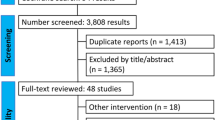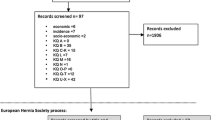Abstract
Despite growing popularity and potential advantages of robotics in general surgery, there is very little published data regarding robotic inguinal hernia repair. This study examines a single surgeon’s early experience with robotic TAPP inguinal hernia repair compared with laparoscopic TAPP repair in terms of feasibility and cost. We performed a retrospective review of 63 consecutive patients (24 laparoscopic and 39 robotic) who underwent inguinal hernia repair between December 2012–December 2014 at a single institution by a single surgeon. Data examined included gender, age, BMI, operative times, recovery room times, pain scale ratings, and cost. Patient groups were the same in terms of age and BMI. The mean operative time (77.5 vs 60.7 min, p = 0.001) and room time (109.3 vs 93.0 min, p = 0.001) were significantly longer for the robotic vs the laparoscopic patients. Recovery room time (109.1 vs 133.5 min, p = 0.026) and average pain scores in recovery (2.5 vs 3.8, p = 0.02) were significantly less for the robotic group. The average direct cost of the laparoscopic group was $3216 compared with $3479 for the robotic group. The average contribution margin for the laparoscopic group was $2396 compared with $2489 for the robotic group. Robotic TAPP inguinal hernia repair had longer operative times, but patients spent less time in recovery and noted less pain than patients who underwent laparoscopic TAPP inguinal hernia repair. The direct cost and contribution margin are nearly equivalent. These results should allow the continued investigation of this technique without concern over excess cost.


Similar content being viewed by others
References
Hussain A, Malik A, Halim MU, Ali AM (2014) The use of robotics in surgery: a review. Int J Clin Pract 68:1376–1382. doi:10.1111/ijcp.12492
Papanikolau IG (2014) Robotic surgery for colorectal cancer: systematic review of the literature. Surg Laparosc Endo Pecurtan Tech 24:478–483
Ruurda JP, Broeders IAMJ, Pulles B, Kappelhof FM, van der Werken C (2004) Manual robot assisted endoscopic suturing: time-action analysis in an experimental model. Surg Endosc 18:1249–1252
Sleeper J, Lotan Y. (2011) The cost-effectiveness of robotic-assisted laparoscopic procedures in urologic surgery in the USA. Expert Review of Medical Devices. 8(1): 97. Health Referece Academic. Web. Dec 2014
Kenngott HG, Fischer L, Nickel F, Rom J, Rasswiler J, Müller-Stich BP (2011) Status of robotic assistance—a less traumatic and more accurate minimally invasive surgery? Langenbecks Arch Surg 397:333–341
Marecik SJ, Chaudhry V, Jan A, Pearl RK, Park JJ, Prasad LM (2006) A comparison of robotic, laparoscipic, and hand-sewn intestinal sutured anastomses performed by residents. Am J Surg 193:349–355
Cetrulo LN, Harmon J, Ortiz J, Canter D, Joshi AR (2014) Case report of a robotic-assisted laparoscopic repair of a giant incarcerated recurrent inguinal hernia containing bladder and ureters. Int J Med Robot. doi:10.1002/rcs.1597
Collins JN, Britt RC, Britt LD (2011) Concomitant robotic repair of inguinal hernia with robotic prostatectomy. Am Surg 77:238–239
Joshi AR, Spivak J, Rubach E, Goldberg G, DeNoto G (2010) Concurrent robotic trans-abdominal pre-peritoneal (TAP) herniorrhaphy during robotic-assisted radical prostatectomy. Int J Med Robot 6:311–314. doi:10.1002/rcs.334
Lee DK, Montgomery DP, Porter JR (2013) Concurrent transperitoneal repair for incidentally detected inguinal hernias during robotically assisted radical prostatectomy. Urology 82:1320–1322. doi:10.1016/j.urology.2013.08.028
Finley DS, Savatta D, Rodriguez E, Kopelan A, Ahlering TE (2008) Transperitoneal robotic-assisted laparoscopic radical prostatectomy and inguinal herniorrhaphy. J Robotic Surg 1:269–272
Cavazzola LT, Rosen MJ (2013) Laparoscopic versus open inguinal hernia repair. Surg Clin N Am 93:1269–1279
Kleidari B, Mahmoudieh M, Yaribakht M, Homaei Z (2014) Mesh fixation in TAPP laparoscopic hernia repair: introduction of a new method in a prospective randomized trial. Surg Endosc 28:531–536
Author information
Authors and Affiliations
Corresponding author
Ethics declarations
Conflict of interest
Authors Kimberly E. Waite and Patrick J. Doyle declare that they have no conflicts of interest. Author Mark A. Herman declares no conflict of interest during the study period and data collection. Subsequent to preparation of the manuscript, Mark A. Herman declares that he became a consultant for Intuitive Surgical, Inc. for case observations and proctoring.
Rights and permissions
About this article
Cite this article
Waite, K.E., Herman, M.A. & Doyle, P.J. Comparison of robotic versus laparoscopic transabdominal preperitoneal (TAPP) inguinal hernia repair. J Robotic Surg 10, 239–244 (2016). https://doi.org/10.1007/s11701-016-0580-1
Received:
Accepted:
Published:
Issue Date:
DOI: https://doi.org/10.1007/s11701-016-0580-1




